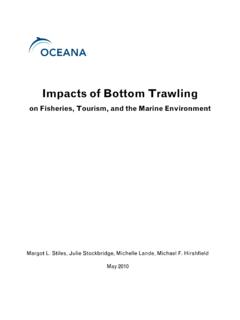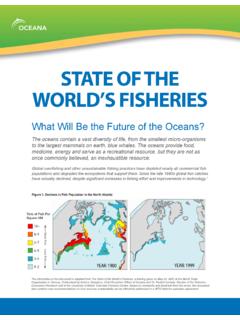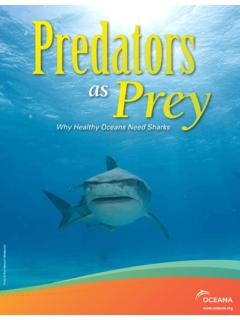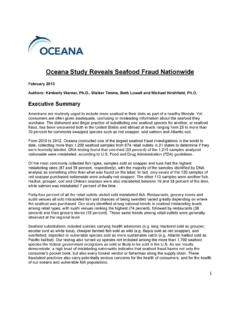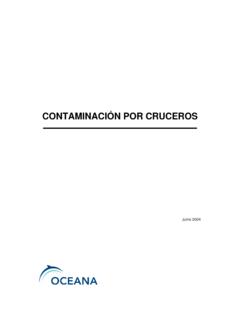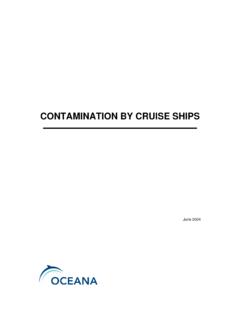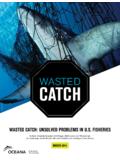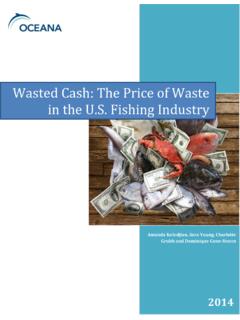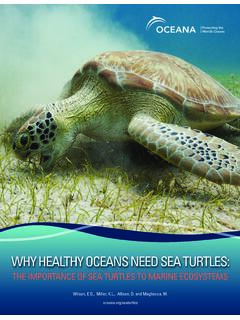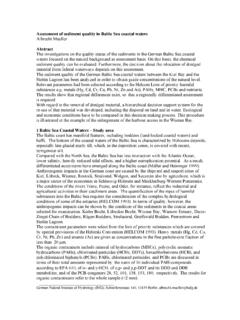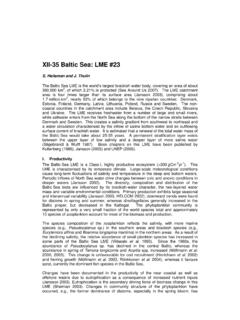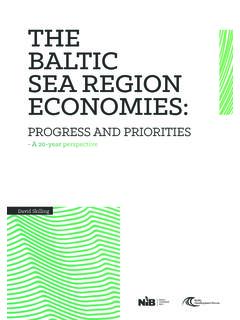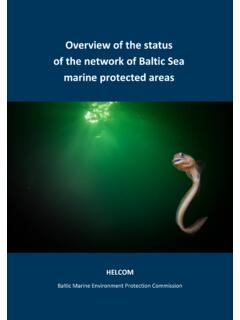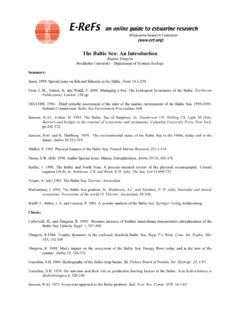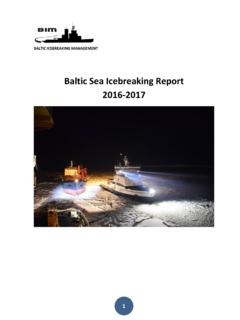Transcription of for ecologically important areas in the Baltic Sea Baltic
1 Plaza de Espa a - Leganitos, 4728013 Madrid (Spain)Tel.: + 34 911 440 880 Fax: + 34 911 440 Montoyer, 391000 Brussels (Belgium)Tel.: + 32 (0) 2 513 22 42 Fax: + 32 (0) 2 513 22 16, 4 sal1051 Copenhagen (Denmark)Phone: + 45 Connecticut Ave., NW, 5th FloorWashington , 20036 (USA)Tel.: + 1 (202) 833 3900 Fax: + 1 (202) 833 Cor. Regent and Dean City, Belize, : + 501 227 2705 Fax: + 501 227 Condell 520,Providencia, Santiago (Chile)CP 7500875 Tel.: + 56 2 925 5600 Fax: + 56 2 925 proposals for ecologically important areas in the Baltic SeaBalticBalticConservation proposals for ecologically important areas in the Baltic SeaAcknowledgments This report was made possible thanks to the generous support of the Arcadia Foundation and Zennstr m thanks to following persons and institutions for all information, documents and other help.
2 Michael Olesen (Marine Biological Section, Department of Biology, University of Copenhagen), Anja Gadg rd Boye (the Danish AgriFish Agency, Ministry of Food, Agriculture and Fisheries), Jos Kielgast (University of Copenhagen), Orbicon, Lone Reers Hansen (the Danish Nature Agency, Ministry of the Environment), Ole S. Tendal (Natural History Museum, University of Copenhagen).Estonia: Liina Vaher (Officer, Estonian Ministry of Environment).Finland: Inkeri Ahonen ( lands landskapsregering), Penina Blankett (Ministry of the Environment), Essi Keskinen (Mets hallitus), Kirsi Kostamo (Finnish Environment Institute), Marcus Lindholm ( lands landskapsregering), Esa Niinivirta (Ministry of Environment), Markku Viitasalo (Finnish Environment Institute).
3 Germany: Dieter Boedeker (Federal Agency for Nature Conservation, Isle of Vilm), Romy Schroeder (Federal Ministry for the Environment, Nature Conservation and Nuclear Safety, Protection of the Marine Environment, International Law on the Protection of the Marine Environment).Latvia: Diana Kampane (Ministry of Environmental Protection and Regional Development).Lithuania: Dziugas Anuskevicius (Protected areas Strategy Division, Ministry of Environment), Algirdas Klimavicius (Protected areas Strategy Division, Ministry of Environment).Poland: Andrzej Ginalski (General Directorate for Environmental Protection, Natura 2000 Department).Sweden: Johnny Berglund (V sterbotten county), Lars Gezelius ( stergotlands county), Maria Kiln s (V stra G talands county), Mikael Lindberg (Uppsala county), Cecilia Lindblad (Swedish Environmental Protection Agency), Marie L fberg (Sk ne county), Fredrik Nordwall (Swedish Agency for Marine and Water Management), Cecilia Nyberg (G vleborg county), Lotta Nyg rd (V sternorrland county), Anne-Li Stenman (Swedish Environment Protection Agency), Eva Stigh ll (Swedish Environment Protection Agency), Karl Svanberg (S dermanland county).
4 Portions of this report are intellectual property of ESRI and its licensors and are used under license. Copyright ESRI and its of the information gathered in this report is permitted as long as OCEANA is cited as the 2011 BalticConservation proposals for ecologically important areas in the Baltic Sea1. Introduction 042. Characteristics of the Baltic Sea 10 Status of the Baltic Sea 14 Management of the protected areas network in the Baltic Sea 183. Methods 204. Baltic Sea species, habitats and communities 24 Classification of habitats and communities 27 Pelagic, offshore (deep) waters 28 Benthic habitats and communities 28 Reefs 28 Mytilus beds Modiolus beds Submarine structures made by leaking gases 30 Bubbling reefs and gas seepages Pockmarks Sandbanks 31 Macrophyte meadows and beds 31 Macroalgae communities Kelp Chara meadows Sea grass meadows Water moss Soft bottom communities 35 Macoma community Abra community Echinoderms Haploops communities Tube worm communities Saduria community Monoporeia community Sea pens with burrowing megafauna Maerl beds Sponge communities 40 Coral gardens 415.
5 Results 42 Kattegat 45 Kattegat trench Djupa r nnan trench Groves Flak Ven island 57 Klints bank 62 Hanko peninsula 64 land Islands 67 Bothnian Bay 71 Bothnian Bay deep Ulkokrunni6. Conclusions 767. Recommendations for the better protection and management of Baltic Sea biodiversity 82 Annex 88 Annex I 90 Annex II 114 Annex III 118 References 12241. Introduction5 Bubbling reef with rich biodiversity, Kattegat. OCEANA/ Carlos Minguell6 The Baltic Sea is one of the most peculiar seas in the world. With an average depth of only 55 meters, it is much shallower than oceans. The salinity of the Baltic Sea varies from levels similar to the ocean in Kattegat to sweetwater salinity levels in the Bay of Bothnia.
6 Besides its unique biodiversity, the Baltic Sea is also extremely valuable to the 85 million inhabitants living in the catchment area. The coastline is shared by nine countries: Denmark, Estonia, Finland, Germany, Latvia, Lithuania, Poland, The Russian Federation, and to its brackish conditions, the Baltic Sea is a highly stressful environment for most marine organisms. Only a limited number of species have successfully colonized this special environment. The salinity is too low for most Atlantic and North Sea species, and too high for many freshwater species. Still, a mixture of marine and freshwater species has adapted to this brackish water environment. The Baltic Sea is also a relatively young sea and; therefore, colonization of species since the last glacial period is still on going (Bonsdorff 2006).
7 Due to these physical facts, the Baltic Sea is characterized with special biodiversity and simple systems where each species plays an important role in maintaining the structure and dynamics of the whole system. If one species disappears, it may cause irreversible damage to the whole network because no other species may have the same ecological requirements to replace the vanished one. These factors make the Baltic Sea a particularly fragile ecosystem. It is extremely vulnerable to human induced pollution and disturbances. Tragically, this fragile sea is currently considered to be one of the most polluted sea areas in the world (HELCOM 2010a). The ecosystems of the Baltic Sea are severely threatened and disturbed mainly by eutrophication, destructive fishing practices and overfishing, loss of habitats and species, inputs of harmful substance and intense maritime , founded in 2001, is the largest international organization focused solely on ocean conservation and the protection of marine ecosystems and endangered species.
8 Offices in Europe, North America, Central America and South America work together on a limited number of directed campaigns to help return the oceans to their former levels of hauling the nets, the Bothnian Bay, Sweden. OCEANA/ Carlos MinguellRed seaweed (Delesseria sanguinea), baked bean ascidian (Dendrodoa grossularia), breadcrumb sponge (Halichondria panicea), Kattegat, Sweden. OCEANA/ Carlos MinguellBaltic expedition7In the beginning of 2011, Oceana opened a new office in Copenhagen to further concentrate its efforts on the conservation of the Baltic Sea. Work in Copenhagen started with a two month research expedition covering all of the sub basins and countries of the Baltic Sea.
9 In the course of the expedition, Oceana documented biodiversity and its status both inside designated marine protected areas and in areas not currently protected, some of which were identified as important marine habitats and ecosystems that deserve little mermaid with Hanse Explorer in the background in the harbour of Copenhagen, Denmark. OCEANA/ Carlos MinguellOceana s goal is to have 30 per cent of the Baltic Sea effectively conserved with well managed marine protected areas and strictly protected no take zones, particularly in areas with important fish habitats. This report introduces the main findings of the expedition and, based on the evidence collected, proposes new areas to be included in the current network of protected findings will also promote the work already in motion by several political European Union (EU) processes.
10 The primary EU process that is currently on going is the implementation of the Marine Strategy Framework Directive (MSFD, Anon. 2008) that obliges Member States to achieve Good Environmental Status for the Baltic Sea by 2020 through an integrated approach to ecosystems and efforts to contain human activities within sustainable levels. Good Environmental Status means that the overall state of the environment in marine waters provides ecologically diverse and dynamic oceans and seas which are healthy and productive. Use of the marine environment must be kept at a sustainable level that safeguards potential uses and activities by current and future generations. This means the structure, functions and processes of marine ecosystems have to be fully considered, marine species and habitats must be protected and human induced decline of biodiversity main legal obligations concerning designation of Marine Protected areas (MPAs) in the EU are provided in the Habitats Directive (Anon.)
